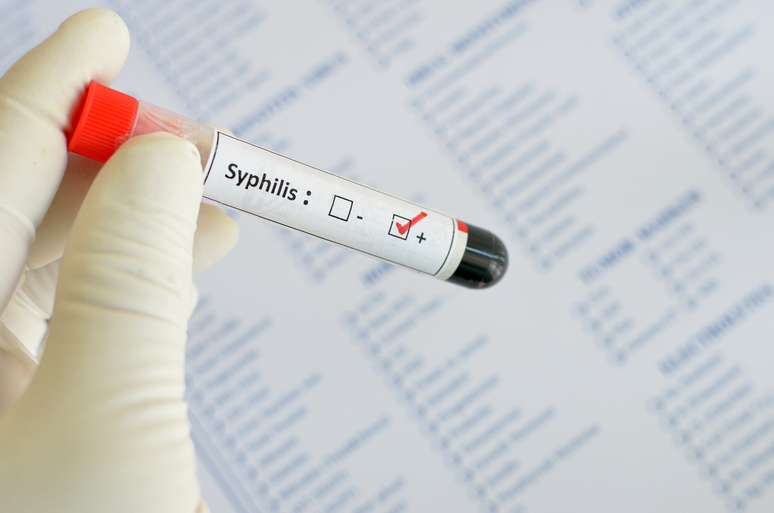In some countries, doxyPEP has been used as a means to prevent contamination in at-risk groups
According to the Ministry of Health, syphilis cases have increased in Brazil across all age groups and genders since the pandemic. In 2021 there were 167,523 cases, a historical record, while in the first half of 2022 (last update) more than 122 thousand new cases were recorded, according to the epidemiological bulletin.
Syphilis is a Sexually transmitted infection (STI) caused by bacteria Pale treponema. It can present different clinical manifestations and different stages and is transmitted mainly through sexual intercourse without a condom with an infected person or to the child during pregnancy or childbirth.
It is also transmitted through blood and sharing needles also causes syphilis, as well as being congenital. Pregnant women who have syphilis can transmit it to the baby, with very serious complications, up to death”, explains Danilo Galante, urologist and sexologist.
What is congenital syphilis?
Congenital syphilis occurs when the disease is passed from the mother with untreated or inadequately treated syphilis to the baby during pregnancy. And how to prevent the transmission of congenital syphilis?
“Just do prenatal care. By doing prenatal care, the pregnant woman is diagnosed with syphilis and can treat it, reducing the risk of transmission to the baby. It’s the same with acquired syphilis: the way to solve congenital syphilis is to improve coverage, testing and treatment,” says Rico Vasconcelos, infectious disease doctor and researcher at FMUSP.
Symptoms of syphilis and its stages
In the early stages, known as primary syphilisaccording to the Ministry of Health, syphilis presents:
- Wound, usually single, at the entry point of the bacteria (penis, vulva, vagina, cervix, anus, mouth or other points of the skin), which appears between 10 and 90 days after infection. This lesion is rich in bacteria and is called “hard cancer“
- It normally does not hurt, does not itch, does not burn and there is no pus and may be accompanied by lumps in the groin
- This wound disappears on its own, regardless of treatment.
TO secondary syphilisthe signs are:
- Signs and symptoms appear six weeks to six months after the initial wound appears and heals
- Spots, usually non-itchy, may appear on the body, including on the palms of the hands and soles of the feet. These lesions are rich in bacteria
- Fever, malaise, headache, swelling of the body may occur
- The spots disappear within a few weeks, regardless of treatment, giving the false impression of healing.
There may be an asymptomatic phase, known as latent syphilis. In this case no signs or symptoms appear, being divided into recent latent (up to a year of infection) and late latent (more than a year of infection). “The duration of this phase is variable and can be interrupted by the appearance of signs and symptoms of the secondary or tertiary form”, we read on the Ministry of Health website.
Already the tertiary phase:
- It can appear between 1 and 40 years from the beginning of the infection
- It usually presents signs and symptoms, mainly skin, bone, cardiovascular and neurological lesions, which can lead to death
- A person can have syphilis and not know it, because the disease can appear and disappear, but remain dormant in the body. That’s why it’s important to protect yourself, get tested and, if the infection is detected, treat it correctly.
About the symptoms
The wound that appears in the primary stage lasts for a while and then disappears, which can prevent many people from seeking treatment. adequate treatment. “It disappears and the patient feels that he is cured, but in reality it is only primary syphilis, which will evolve into secondary, which is a disease of syphilis in the blood. This can also lead to joint pain, fever, prostration, headache and muscle pain”, underlines Danilo.
According to him, in these cases, syphilis is very similar to a virus, dengue fever and, if not treated, can transform into tertiary syphilis, that is, when it affects the central nervous system, the neurological part, which can generate serious and permanent complications.
Diagnosis and treatment of syphilis
If the infection is not diagnosed and treated, it can cause serious complications, affecting the heart, brain, eyes, bones and some other internal organs. Therefore, it is important to raise public awareness on the topic and on early diagnosiswhich is carried out through physical examination and laboratory tests.
Over the treatment of syphilis, when diagnosed, especially in the early stage, is very simple. “Treatment is with antibiotics, penicillin. Here in Brazil we do it with benzetacil”, explains Dr. Maria Carolina Dalboni, endocrine gynecologist, obstetrician and specialist in hormone replacement therapy.
Is syphilis curable?
Yes the Syphilis has a cure. After treatment with antibiotics, the person recovers completely and must undergo periodic laboratory tests. Once recovered, the person no longer transmits syphilis.
Can a person get syphilis more than once?
Yes, a person can get syphilis more than once. A person can contract syphilis any time they come into contact with the bacteria. Therefore, it is important to use a condom in all sexual intercourse for preventive purposes. In other words, having already had syphilis once does not promote immunity..
DoxyPEP for syphilis
In recent times, doxycycline, a drug used to treat bacterial sexually transmitted diseases, has been tested as a way to prevent an infection such as syphilis. This treatment is called doxyPEP.
In the United States, for example, some states already recommend doxyPEP to men who have had sex with trans men or women with at least one bacterial STI in the past 12 months. According to studies, the preventive method is about 65% effective against new infections of sexually transmitted diseases, such as gonorrhea, chlamydia and syphilis.
It was noted that some patients who took it within 72 hours of exposure without preservatives avoided contracting syphilis in approximately 50%-70% of cases (results vary). It is not a vaccine, it is an already existing antibiotic, a way to avoid contracting the disease“, says Danilo.
It is worth noting that doxyPEP is not only used for syphilis. “It is a prevention strategy against bacterial sexually transmitted diseases, such as syphilis, gonorrhea and chlamydia, which consists in taking, after sexual intercourse, a single dose of the antibiotic doxycycline, the same one that can be used to treat syphilis,” explains Rico.
According to him, studies show that protection is greater against syphilis and chlamydia and less against gonorrhea. “Right now the scientific world is determining who should take doxyPEP, especially whether or not there is a risk of selection for multidrug-resistant bacteria due to the use of this antibiotic.”
He explains that the United States is the only place in the world that already officially recommends it and that here in Brazil the discussion is still at the beginning. “But yes, it helps a lot. There are studies that show it reduces the transmission of syphilis by almost 90%“, he concludes.
Another example similar to this prevention is PEP in the case of HIV. It is an emergency drug, that is, if the person has been exposed to the risk of contracting HIV he or she must contact a specialized health service and request drugs for post-exposure prophylaxis. The patient has up to 72 hours after exposure to begin treatment, which is also carried out with drugs and lasts 28 days. This treatment is available on SUS.
Source: Terra
Ben Stock is a lifestyle journalist and author at Gossipify. He writes about topics such as health, wellness, travel, food and home decor. He provides practical advice and inspiration to improve well-being, keeps readers up to date with latest lifestyle news and trends, known for his engaging writing style, in-depth analysis and unique perspectives.








